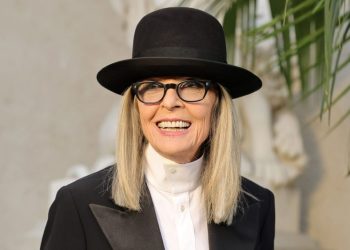Diane KeatonTHE Oscar-winning star of “Annie Hall” The films “The Godfather” and “Father of the Bride”, whose quirky, vibrant manner and depth made her one of the most unique actors of a generation, have passed away. She was 79 years old.
People Magazine reported Saturday that she died in California with her loved ones, citing a family spokesperson. No further details were immediately available and representatives for Keaton did not immediately respond to inquiries from The Associated Press.
The unexpected news was was shocked across the world.
“She was hilarious, completely original and completely devoid of the guile or competitiveness that one would expect from such a star. What you saw was who she was… oh, la, lala!” Bette Midler said in an Instagram post. She and Keaton starred in “The First Wives Club.”
Keaton was the kind of actress who helped make films iconic and timeless, from her “La-dee-da, la-dee-da” expression as Annie Hall, decked out in that tie, bowler hat, vest and khakis, to her. heartbreaking turn as Kay Adams, the woman unfortunate enough to join the Corleone family.
Her star performances in the 1970s, many of which were in Woody Allen films, weren’t a flash in the pan either, and she would continue to charm new generations for decades thanks in part to a longtime collaboration with filmmaker Nancy Meyers.
She played a businessman who unexpectedly inherits a baby in “Baby Boom,” the mother of the bride in the beloved remake of “Father of the Bride,” a newly single woman in “The First Wives Club” and a divorced playwright who becomes involved with Jack Nicholson’s musical director in “Something’s Gotta Give.”
The Oscar winners pose with their statuettes during the Academy Awards in Los Angeles, April 3, 1978, from left to right: Richard Dreyfuss, best actor for “The Goodbye Girl”; Charles H. Joffe, best film for “Annie Hall”; Diane Keaton, best actress for “Annie Hall”; presenter Jack Nicholson and producer Jack Rollins of United Artists. (AP photo, file)
Keaton won her first Academy Award for “Annie Hall” and was nominated three more times, for “Reds,” as journalist and suffragist Louise Bryant, “Marvin’s Room,” as a caregiver who suddenly needs care, and “Something’s Gotta Give,” as a middle-aged divorcee who is the object of several men’s affections.
In his very Keaton way, accepting his Oscar in 1978 she laughed and said, “That’s something.”
Hollywood kid breaks into New York
Keaton was born Diane Hall in January 1946 in Los Angeles, although her family was not part of the film industry she would find herself in. His mother was a housewife and photographer, and his father worked in real estate and civil engineering, and both would inspire his love of the arts, from fashion to architecture.
Keaton was drawn to acting and singing while at school in Santa Ana, California, and she dropped out after a year to try her luck in Manhattan. Actors’ Equity already had Diane Hall in its ranks, and she took Keaton, her mother’s maiden name, as her own.
She studied under Sanford Meisner in New York and credited him with giving him the freedom to “chart the complex terrain of human behavior safely under his guidance. It made playing with fire fun.”
“More than anything, Sanford Meisner helped me learn to appreciate the darker side of behavior,” she wrote in her 2012 memoir, “Then Again.” “I have always had the gift of feeling it, but not yet the courage to delve into such dangerous and enlightening territory.”

FILE – Acting teacher Sanford Meisner, right, greets his former student Diane Keaton at a party thrown in her honor by his students at the Neighborhood Playhouse School in New York, Tuesday evening, Oct. 8, 1980. (AP Photo, File)
She debuted on stage as an understudy in the Broadway production of “Hair” and in Allen’s 1968 “Play It Again, Sam,” for which she received a Tony nomination. And yet she remained deeply self-conscious about her appearance and struggled with bulimia in her 20s.
Becoming a star with “The Godfather” and Woody Allen
Keaton made her film debut in the romantic comedy “Lovers and Other Strangers” in 1970, but her big break would come a few years later when she was cast in Francis Ford Coppola’s “The Godfather,” which won Best Picture and became one of the most beloved films of all time. And yet, even she hesitated to come back for the sequel, although after reading the script, she decided otherwise.
She summed up her role as Kay, a role she never connected to even though she relished the memories of her role with Al Pacino.
The 1970s were an incredibly fruitful period for Keaton, thanks in part to his continued collaboration with Allen in comedic and dramatic roles. She appeared in “Sleeper,” “Love and Death,” “Interiors,” Manhattan,” and the film version of “Play it Again, Sam.” The 1977 crime drama “The Search for Mr. Goodbar” also earned him praise.
Allen and the late Marshall Brickman gave Keaton one of her most iconic roles in “Annie Hall,” the infectious woman of Chippewa Falls from whom Allen’s Alvy Singer can’t get over. The film is considered one of the greatest romantic comedies of all time, with Keaton’s eccentric and self-deprecating Annie at its heart.
In the New York Times, critic Vincent Canby wrote: “As Annie Hall, Miss Keaton appears like Woody Allen’s Liv Ullman. Her camera finds a beauty and emotional resources that somehow escape the attention of other directors. Her Annie Hall is a marvelous weirdo.”
She acknowledged the parallels between Annie Hall and real life, while downplaying them.
“My last name is Hall. Woody and I shared a significant love story, in my opinion, anyway,” she wrote. “I wanted to be a singer. I was insecure and searching for my words.”
Keaton and Allen were also romantically involved, from around 1968, when she met him while auditioning for his play, until around 1974. They subsequently remained collaborators and friends. She then appeared in “Radio Days” in 1987 and “Manhattan Murder Mystery” in 1993.
“He was so hip, with his thick glasses and cool suits,” Keaton wrote in his memoir. “But it was his demeanor that attracted me, the way he gestured, his hands, his cough and his self-deprecating look while he told jokes.”
She was also romantically involved with Pacino, who played her husband in “The Godfather,” and with Warren Beatty, who directed her and with whom she starred in “Reds.” She never married but adopted two children when she was in her fifties: a daughter, Dexter, and a son, Duke.
“I thought the only way to achieve my number one dream, becoming a true Broadway musical star, was to remain a doting girl. Loving a man, a man and becoming a wife, would have to be put aside,” she wrote in her memoir.
“The names changed, from Dave to Woody, then Warren, and finally Al. Could I have made a lasting commitment to them? Hard to say. Subconsciously, I must have known it would never work, and because of that, they would never stop me from achieving my dreams.”
When Keaton met Nancy Meyers
Not all of Keaton’s roles were home runs, like his foray into acting in John le Carré’s adaptation of George Roy Hill’s “Little Drummer Girl.” But in 1987, she would begin another long-running collaboration with Nancy Meyers, which would result in four beloved films. Reviews of that first release, “Baby Boom,” directed by Charles Shyer, might have been mixed at the time, but Pauline Kael even described Keaton’s film as “a glorious comic performance that overcomes many inanities.”
Their next team-up would be in the remake of “Father of the Bride,” directed and co-written by Shyer with Meyers. She and Steve Martin played the bride’s agitated parents, which would become a big hit and spawn a sequel.
In 2003, Meyers would direct her in “Something’s Gotta Give,” a romantic comedy in which she begins a relationship with a playboy philanderer, played by Jack Nicholson, while being pursued by a young doctor, played by Keanu Reeves. Her character Erica Barry, with her beautiful Hamptons home and ivory outfits, was a key inspiration for the recent coastal grandmother fashion trend. It earned her what would be her final Oscar nomination, and she would later call it her favorite film.
She has also directed occasionally, with works including an episode of “Twin Peaks,” a Belinda Carlisle music video and the sister comedy-drama “Hanging Up,” co-written by Noran Epron and Delia Ephron, and she has starred alongside Meg Ryan and Lisa Kudrow.
Keaton continued to work steadily throughout the 2000s, with notable roles in “The Family Stone”, as a dying matriarch reluctant to give her son her ring, in “Morning Glory”, as a morning news anchor, and in “Book Club” films.
She has also written several books, including the memoirs “Then Again” and “Let’s Just Say It Wasn’t Pretty,” as well as an art and design book, “The House that Pinterest Built.”
Keaton was celebrated with a AFI Lifetime Achievement Award in 2017, telling the AP at the time that it was a surreal experience.
“I feel like it’s the wedding I never had, or the big gathering I never had, or the retirement party I never had, or all those things I always avoided — the big party,” she said. “It’s really a big event for me and I’m really, really grateful for it.”
In 2022, she “cemented” her legacy with a hand and foot ceremony in front of the TCL Chinese Theater in Los Angeles, with her children looking on.
“I don’t think about my cinematic heritage,” she said at the event. “I’m just lucky to have been here in any form. I’m just lucky. I don’t see myself as anything other than that.”
___
AP National Writer Hillel Italy in New York contributed.









